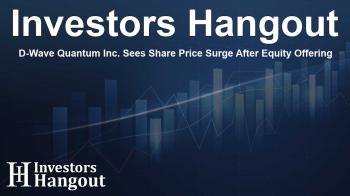D-Wave Quantum Inc. Sees Share Price Surge After Equity Offering

D-Wave Quantum Inc. Sees Share Price Surge After Equity Offering
Recently, D-Wave Quantum Inc (NYSE: QBTS) showcased its strength in the quantum computing sector with a noteworthy announcement. Following the completion of its $400 million at-the-market equity offering, the company's share price surged by more than 19% in less than a week.
This offering, while posing a dilution risk for existing shareholders, has ignited a renewed sense of enthusiasm for D-Wave and its innovative quantum annealing technology. Investors are left curious about what this recent shift means for the company’s future.
Dilution vs. Cash Influx
Even though equity offerings can dilute existing shares, they also provide a valuable influx of capital. For D-Wave, the recent ATM offering raised approximately $15.18 per share on average, significantly boosting the company's cash reserves to an estimated $815 million.
With cash approaching $1 billion, D-Wave’s financial position appears robust, especially compared to other smaller quantum-focused enterprises. This strong balance sheet positions D-Wave favorably against its competitors, primarily not major tech firms that are also working in the quantum domain.
Investors are likely encouraged by the high average sale price achieved during this equity issuance. This price demonstrates a premium of 149% over the last ATM offering price, reflecting a confidence among investors in the rising value of D-Wave's shares since the earlier offerings last year.
Cash Can Continue to Drive Major Developments
The excitement surrounding D-Wave post-offering can also be attributed to its recent track record of effectively utilizing its cash reserves. Notable advancements in technology, like the achievement of quantum supremacy earlier this year and the recent introduction of the Advantage2 processor, have illustrated the company’s rapid progress.
Moreover, D-Wave is strategically leveraging its cash to forge meaningful partnerships. Collaborations with esteemed institutions, including South Korea’s Yonsei University and Japan's Docomo, have the potential to expand D-Wave's reach and customer base significantly.
The Greatest Advantage of All Is Time
Perhaps the most significant advantage of the additional capital is the time it affords D-Wave. While the company continues to grapple with profitability, it is vital to note that its revenue is climbing—albeit from a smaller base. In its latest quarter, D-Wave reported $15 million in revenue, which, while modest, marks a critical step towards broader acceptance of its technologies.
Currently, D-Wave relies on one-off sales of its quantum computing products to generate revenue. Although this approach has worked in the short run, widespread adoption of D-Wave’s quantum technologies is essential for sustainable growth.
Encouragingly, bookings for the fourth quarter have shown an astounding 500% increase year-over-year, suggesting a promising pathway for consistent revenue growth as existing enterprise and government contracts come to fruition.
Caution Is Still Warranted
Nevertheless, skepticism remains among some investors regarding D-Wave’s long-term prospects. Advancements made by competitors suggest that the advantages of D-Wave’s annealing technology might not be as extensive as once presumed. If this turns out to be necessary, D-Wave could face heightened competition as the quantum technology market enters a more mature phase.
Furthermore, the timeline for quantum computing to become commercially viable is still uncertain. Some analysts warn that significant milestones may be years away, implying that D-Wave must strategize to endure until then—even with healthy cash reserves.
Lastly, with D-Wave's high price-to-sales ratio raising red flags for potential overvaluation, the effects of dilution from equity offerings may not ease investor concerns. Overall, while the current scenario seems optimistic, the inherent risks in the quantum computing market cannot be overlooked.
Frequently Asked Questions
What caused D-Wave's share price increase?
The increase in D-Wave's share price was primarily due to the successful completion of its $400 million equity offering, which reinvigorated investor interest.
How much cash does D-Wave currently have?
D-Wave's cash reserves have surged to an estimated $815 million following the equity offering, positioning the company strongly in the quantum computing sector.
What recent technological advancements has D-Wave made?
D-Wave achieved quantum supremacy earlier this year and released the Advantage2 processor, which is available both in the cloud and on-site.
Is D-Wave profitable?
D-Wave is currently not profitable, reporting $15 million in small quarterly revenue, yet its growth trajectory shows promise.
What risks does D-Wave face moving forward?
Risks for D-Wave include potential competition from peers with advanced technology and uncertainty around the timeline for quantum computing to reach commercial viability.
About The Author
Contact Addison Perry privately here. Or send an email with ATTN: Addison Perry as the subject to contact@investorshangout.com.
About Investors Hangout
Investors Hangout is a leading online stock forum for financial discussion and learning, offering a wide range of free tools and resources. It draws in traders of all levels, who exchange market knowledge, investigate trading tactics, and keep an eye on industry developments in real time. Featuring financial articles, stock message boards, quotes, charts, company profiles, and live news updates. Through cooperative learning and a wealth of informational resources, it helps users from novices creating their first portfolios to experts honing their techniques. Join Investors Hangout today: https://investorshangout.com/
The content of this article is based on factual, publicly available information and does not represent legal, financial, or investment advice. Investors Hangout does not offer financial advice, and the author is not a licensed financial advisor. Consult a qualified advisor before making any financial or investment decisions based on this article. This article should not be considered advice to purchase, sell, or hold any securities or other investments. If any of the material provided here is inaccurate, please contact us for corrections.

